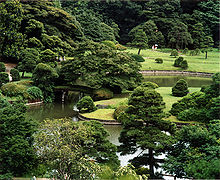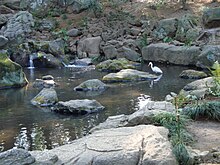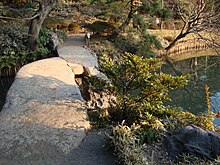Rikugi-en
The Rikugi-en ( Japanese 六 義 園 ) or "Rikugi Park" is one of the most important changing gardens of the Edo period in Tokyo. He is one of the "Excellent Attractions" (tokubetsu meishō) of Japan.
history
Yanagisawa Yoshiyasu (1658-1714), a close confidante of the fifth Shogun Tokugawa Tsunayoshi , received from this in the 4th month of 1695 in Komagome on the northern edge of Edo, on the road to Nikko, a site on which he was a secondary residence and up 1702 created a convertible garden. Its name refers to the six principles of Chinese poetry. Of the six, three are related to type and content and can be reproduced roughly as follows:
- "Popular" ( 風 , fū), "courtly" ( 雅 , ga), "honoring ancestors" ( 頌 , shō)
and another three as shown
- “Direct” ( 賦 , fu), “comparing” ( 比 , hi), “touching” ( 興 , kyō).
These six principles were adopted from Japan and adapted to the art of waka poetry. Yanagisawa dealt with it and put his point of view in the "Rikugien no ki". At his request, court aristocrats in Kyoto wrote 12 waka for specific locations in the garden.
After Yanagisawa's death, the garden fell into disrepair. At the beginning of the Meiji period, Mitsubishi founder Iwasaki Yatarō acquired the property, who restored the garden and surrounded it with a high brick wall typical of the time. In 1938 the Iwasaki family donated the garden to the city.
The park
The park, located on the Musashino Plain, was designed as a miniature landscape with raised hills and water. The park gets its water from the Sengawa jōsui ( 千 川 上水 ), which supplies the north of Edo with water. 88 particularly beautiful places in the park have been given names that refer to places in Japan, China, places in songs or simply to old times.
In the large pond in the middle of the park there is the usual "inner island", which can be reached via a bridge. There are two hills on the island, called Imoyama, Seyama ( 妹 山 ・ 背 山 ), which symbolize man and woman as a couple. There is also a small "island of the blessed" ( 蓬莱 島 , Hōraijima) in the pond . A "floating turtle bridge" ( 亀 浮橋 , kame-ukihashi), consisting of humpback islands, leads to it. A “stretching dragon” ( 臥 竜 石 , Garyū seki) can also be seen in the pond. The bank of the pond is varied with “tidal harbor ” ( 出 汐 の 湊 , Deshio no minato), “seagrass banks” ( 玉 藻 の 磯 , Tamamo no iso) and “source banks” ( 吹 上 浜 , Fukiage hama).
The highest point in the garden is taken by the "Wisteria Pass" ( 藤 代 峠 , Fujishiro tōge). The narrow, winding “spider path” ( 蛛 道 , Sasakani no michi) leads up. The Togetsukyō ( 渡 月 橋 ) and three other bridges lead to this hill, which is completely surrounded by watercourses .
In the southwest part of the park, stones, the Mizuwake ishi ( 水分 石 ), are placed in a ditch that carries water . There is also the "plover bridge" ( 千 鳥 橋 , Chidori-bashi). - There are a few teahouses in the park, such as the simple Taki-mi no chaya ( 滝 見 の 茶屋 ), but also larger pavilions that can be rented. The Senri-ba ( 千里 場 ), a track for riding horses, has been preserved on the northwest edge of the park .
The park is known for its flowers, especially the azaleas, the shidare cherry ( 枝 垂 桜 ) in spring and the color of the leaves in autumn. Far from the center of the city and originally a world of its own, the park is now enclosed by high-rise buildings.
Characteristics
- Operator: Tokyo Prefecture, admission is charged
- Opening: October 16, 1938
- Area: 87,809.41
- Tree population: 6,340 trees, 28,700 bushes
- Facilities: rentable pavilions, kiosk
Individual evidence
- ↑ Filed in the Shijing collection of poems .
- ↑ Matthew D. Firestone, Timothy N. Hornyak, "Tokyo," Mairdumont Verlag, 2009, ISBN 978-3-8297-1629-1 , 64
Remarks
- ↑ Yanagisawa, a highly educated lower samurai, was envied for his access to the Shogun and was controversial. He received the title Mino-no-kami, rose to Chancellor (Rōjū), received the Kōfu-han as a fief. Tsunayoshi is said to have visited him 58 times. After Tsunayoshi's death in 1709, he was ousted and lived in seclusion in the park.
- ↑ The Togetsu Bridge refers to the large bridge over the Hozu River in Arashiyama (Kyōto), which is said to have received its name, such as "Walk to the Moon" from Kameyama Tennō (1249-1305). This one consists of two long stone beams one behind the other, which - supported by a wide pillar - butt against each other offset to the side. This is a commonly found bridge shape in Japan.
swell
- Leaflet of the park
- Tōkyō-to (Ed.): Rikugien , in: Toritsu kōen gaido, 1995.
Web links
Coordinates: 35 ° 43 ′ 59 " N , 139 ° 44 ′ 48" E




